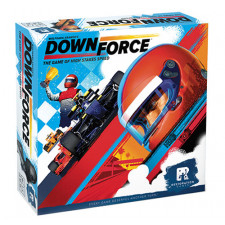Downforce Review
on Aug 23, 2017
Like a master painter (or Reiner Knizia), Wolfgang Kramer is a creator that understands the value of implementing, developing, and re-contextualizing elements previously explored in past work. When he released his first game, Tempo, in 1974, he hit on this interesting mechanic whereby players would race to move pawns up a grid but with all pawns being mutually controlled by all players. More than that though, it was also a betting game where players would wager on the outcome based on the cards in their hands, which activate the pawns. But the real kicker is that those cards move one, some or all of the pawns so you've got to make smart choices about when to play and who to advance.
But it wasn't until 1980 that this idea really came into full fruition. Reframing what was originally an abstract design as a Formula One racing game bearing the name of F1 legend Niki Lauda, Tempo found its line and over the years it would be reprinted several times and with different titles, most notably in Europe as Top Race and in the US as Daytona 500, both from the mid-1990s. Mayfair did a version as well, Detroit-Cleveland Grand Prix. And now, Restoration Games has produced a new edition as Downforce with some very minor updates courtesy a design legend in his own right, Rob Daviau.
The history lesson is important, I think, because Downforce - or whatever you may have formerly known this design as - is the latest iteration of what I think may be the best racing board game ever created. It is timeless, weathering trends and outlasting them, and it remains a tremendous family game that anyone can play and enjoy. It deftly avoids the pitfalls of many lesser designs. It's fast on its feet and moves whereas many top titles in this genre are paradoxically slow-paced and overly calculatory. It puts a full field of cars on the track regardless of player count. It's full of drama and unexpected outcomes. It's just plain fun.
Before the game starts, you draw a car color card and a special power - the latter is one of Daviau's additions and it is respectful to the original design and totally optional. Everyone stakes a bid to take ownership of that combination based on the cards they have in hand. If you've got a lot of high value cards that move that color, it's a good idea to bid high. There is no money involved at this point; you simply bank your bid against your endgame winnings. And players may wind up in control of multiple cars, which can be lucrative...or a financial disaster. In addition to the car and ability, you also get a special 8-value speed card to give your driver a boost.
Once the six cars are settled up, the player in pole position plays a card that will move one, some or all of the cars 1-6 spaces based on their color. There are also wild values. Movement is very simple, and each of the two tracks features a couple of bottlenecks and opportunities for tactical maneuvering.
There are three checkpoints along the track, and once a car passes one of them everyone stops to place a single, secret bet on which car they think will win. It doesn't have to be a car they own, and the earlier you bet the more you can win because of the higher risk involved. So by the last third of the race, you might find yourself trying to help someone else's car win. Or you might be intentionally sandbagging your car that you suspect others may have bet on early in the game.
Once every car crosses the finish line, winnings are calculated by adding the total win, place and show earnings for the first three finishers to your bets, should any of your picks finish first. Then you subtract what you bid at the beginning of the game and whoever jots down the highest value on their score sheet wins the game.
There's obviously a lot more going on than winning the actual race. There's a neat psychological game going on parallel to the basic racing action. I've been in situations where I've had the lead car for all three checkpoints and then just completely refused to move it at the end, knowing that others had wasted their bets on it. I've made a first round bet on a last place car someone else controlled because I had high value cards for it and my betting on it was more lucrative than winning with my own team. Expect lots of yelling and excitement at the end when it all shakes down when these kinds of shenanigans are happening.
At about 45 minutes and explainable in about five minutes, this is a racing game for everyone. Another addition to this edition is a very simple set of rules for younger kids that turn it more into a straight racing game and there is also a two player variant. I have yet to introduce this game to someone that didn't love it, and I am very pleased that Restoration's printing is outstanding with my only complaint being that the board art is incredibly cheap-looking and dull compared to the spectacular, modern graphic design of the box and card illustrations. As far as how it stacks up against older editions, this is the one to buy. It's also available for under $30, which is something I especially like to see for family games like this.
This edition of Downforce - or Top Race, or Daytona 500, or whatever- is the definitive release of a masterpiece.

 Customer Support
Customer Support  Subscribe
Subscribe 




 Account
Account  Wishlist
Wishlist 

